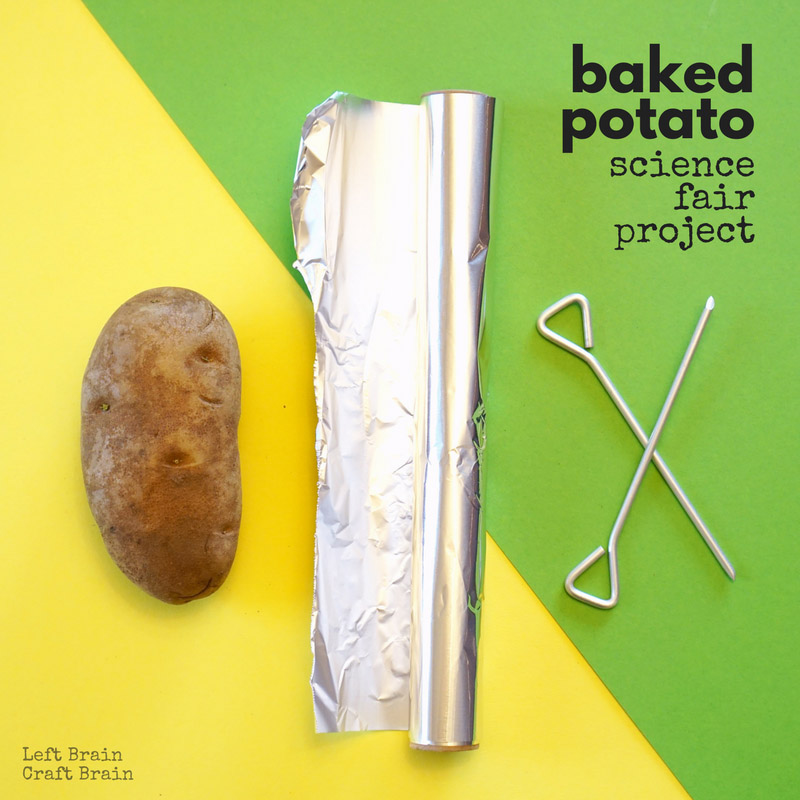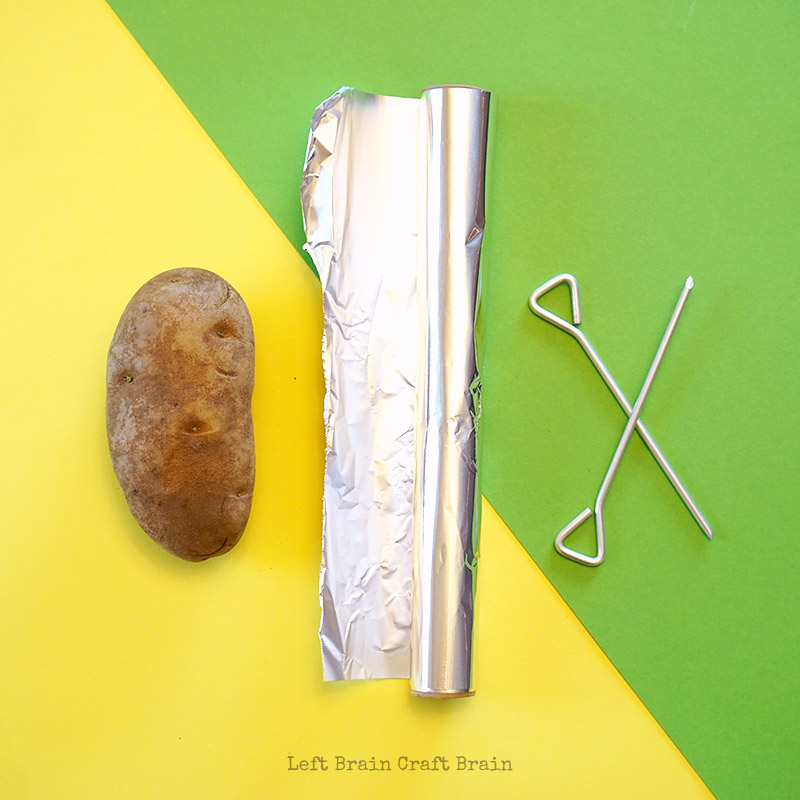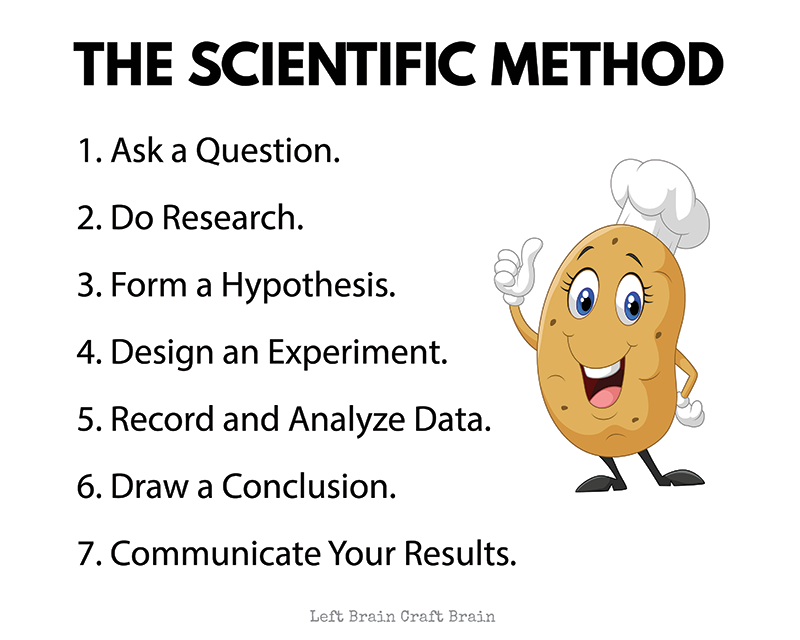It’s science fair season! Are your kids working on something yet? This year, for kindergarten, I got to flash back to the science fair project I did as a kiddo. We asked What’s the Fastest Way to Bake a Potato? And learned all about the Scientific Method. Keep reading for the delicious and easy science fair project and free printable workbook.
This post contains affiliate links.
Baked Potato Science Fair Project Supplies Needed
You don’t need too much for this project and you can definitely use what you have.
- Potatoes – big Russet style potatoes worked for us. Try to get similar sized potatoes to make the experiment fair
- Aluminum foil (regular and heavy duty if desired)
- Baked potato pins
- Timer
- Oven and/or microwave
Potato Scientific Method
At the heart of any good science fair experiment is the Scientific Method. This framework helps think through a problem and come up with an answer. I’m going to walk you through our steps in this project, but be sure to challenge your kiddos to do this themselves. And don’t worry about kids being too young! Preschools can totally comprehend this process even if they can’t write the answers down yet. Turn it into a conversation for them.
Potato Scientific Method
1. Ask a Question – First up is figuring out the problem. The other night we were trying to get dinner on the table, fast. But since I don’t have an Instant Pot, the baked potatoes were the bottle neck. So our question is: “What’s the fastest way to cook a baked potato?”
2. Do Research – So we Googled it. And up came a lot of ideas like wrapping the potatoes in aluminum foil, using baking pins and microwaving the potatoes can all help speed up the process.
3. Form a Hypothesis – We guessed that microwaving a potato would be the fastest way to bake a potato.
4. Design an Experiment – We decided to try 7 different cooking methods. Because that’s how many potatoes we bought! But get creative and make up your own, too.
(SAFETY NOTE!! Don’t use the aluminum foil or pins in the microwave!!!)
Baked in 350° F oven:
- Plain potato
- Potato wrapped in regular aluminum foil
- Potato wrapped in heavy duty aluminum foil
- Potato with baking pin
- Potato wrapped in regular aluminum foil with baking pin
Baked in microwave at full power:
- Plain potato
- Plain potato in glass bowl with plastic wrap over it
You also need to decide what you call done or cooked. We called the potatoes done when a fork easily slid all the way to the center with no resistance.
5. Record and Analyze Data – Grab a notebook and record the cooking times. And be sure to leave enough time to test the potatoes. Potatoes can take an hour to bake in the oven, so don’t try to finish this up right before bed time. For each potato, write down the preparation (like foil and pins) and record the cooking time. Then sort the results from slowest to fastest.
6. Draw a Conclusion – Our results showed that if you need speed, the microwave is the way to go. But if you want crispy potato skin? Go for the oven with only the baking pin. The aluminum foil steams the potatoes a bit, so they’re not quite as crispy.
7. Communicate Your Results – We did this over a delicious dinner of loaded baked potatoes :) It’s a great conversation starter for families!
Baked Potato Recipes
And because if you do this science fair experiment, I know you’re gonna need some recipes for all those baked potatoes :) Yummy recipes like twice-baked potatoes, baked potato casserole and more! We love these Twice Baked Potatoes from Crafty Morning.
More Science Fair Fun
Got some extra potatoes? Build a Potato Battery.
Investigate Why Apples Turn Brown and figure out the best method for keeping them looking fresh.
Or make a Color Changing Chemistry Clock.
28 Days of STEAM – More Learning Fun!
This project is part of an amazing, month-long series of hands on STEAM projects for kids. Click on over to 28 Days of STEAM for 60+ FREE science, tech, engineering, art, and math projects from 30+ education writers. All ready to get your kids excited to learn.











Pingback: 28 Days of STEAM Projects for Kids - Left Brain Craft Brain
Pingback: Fun Kitchen Science Experiments for Kids - Better Than Homework
Pingback: 28 Edible Science Projects You’ll Actually Want to Eat | Education Discussion
Pingback: 30+ Kitchen Science Experiments for Kids - Natural Beach Living
Pingback: 15 Easy Kitchen Science Experiments (With Ingredients You Already Have) - STEM Education Guide
Pingback: 15 Easy Kitchen Science Experiments (With Ingredients You Already Have)
Pingback: Food Science Experiments for Kids | A2Z Homeschooling
Pingback: 50 Stem Activities To Help Kids Think Outside The Box | Atmhaber.com
Pingback: 50 Stem Activities To Help Kids Think Outside the Box - YoursBulletin
Pingback: 50 Stem Activities To Help Kids Think Outside the Box - US Clock News
Pingback: 50 Stem Activities To Help Kids Think Outside the Box - Country Highlights
Pingback: 50 Stem Activities To Help Kids Think Outside the Box – E-Capitals
Pingback: 50 Stem Activities To Help Kids Think Outside The Box - ศึกษาข่าวจากต่างประเทศโดยเรียนบางแสน
Pingback: 50 Stem Activities To Help Kids Think Outside the Box – Technology Perk
Pingback: 50 Stem Activities To Help Kids Think Outside the Box – I-Capitals
Pingback: 50 Stem Activities To Help Kids Think Outside the Box – TodayHeadline
Pingback: 50 Stem Activities To Help Kids Think Outside the Box - School is Open